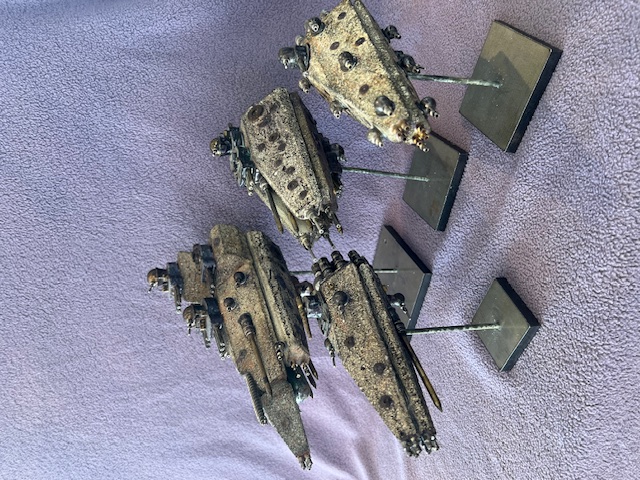Julblog 2025.
Three Dimensional Time!
At last, this seemingly crazy and somewhat occult idea that I’ve speculated upon for decades has started to attract the serious attention of mainstream physicists.
If this hypothesis thesis pans out, it has massive scope and implications for physics, metaphysics and magic.
Garden Statuary – Pan in celebration of Midsummer.
Many hours work with the Turdcrete or Hypertufa has led to the completion of the figure whose wire frame appears on the previous blog. You have to apply the stuff a little at a time and let it at least partially set, or it sags. Black liquid mortar dye in the material supplies the base colour which then gets a dry brushing with green acrylic to create a faux weathered bronze effect. A matched pair of 20 Carat Pear Cut Burmese Rubies for eyes contrasts with the verdigrised surface, or a couple of red glass ones prized from some Indian style costume jewellery earrings will also serve.


Reality from the bottom up.
A man needs a hobby to distract himself from the relentless pursuit of sculpture, so herewith some further thoughts upon the Quanta underlying reality, which may have esoteric implications.
Hypertorus Quantology?
How does reality work?
The Hypersphere Cosmology thesis which remains unfalsified at the time of writing, attempts to describe how it works on the cosmological scale with observational evidence that we can interpret in its favour still coming in.
But what about reality on the fundamental subatomic scale?
Which interpretation of quantum physics do you prefer?
Most interpretations attempt to describe what goes on in the quantum realm in terms of something that we can represent with images and words.
Yet the orthodox ‘Copenhagen’ interpretation asserts that we currently have no way of choosing between any of the interpretations of the ad-hoc and highly abstract mathematics which can accurately predict the probabilities of obtaining some particular measurements. The Copenhagenists insist that we can know nothing about the unobserved states of quanta between measurements, and we cannot, and should not, attribute any kind of reality or word or image description to them. We should merely ‘shut up and calculate’ because the stuff of the world doesn’t seem to behave like macroscopic stuff at all on the quantum level. Thus, we can only make abstract mathematical epistemologies to describe and predict our observations because quanta do not consistently behave like waves or particles or any other macroscopic phenomena that we can imagine.
This does seem an incomplete, unimaginative, and metaphysically unsatisfactory position that becomes more annoying with every reiteration of it.
The Geometric description of reality on the cosmological and macroscale as implied by General Relativity, "Matter tells spacetime how to curve, and curved spacetime tells matter how to move", has proved highly effective in modelling much of the structure and behaviour of the cosmos. (Hypersphere Cosmology builds upon this with added modifications to avoid spacetime singularities.) Surely this behoves us to consider geometric models for the quanta of matter and energy as well.
The standard models of cosmology and quantum physics both share a common problem – the mathematical spacetime singularities they imply inside of black holes and at a big bang, and those that arise from treating quanta as point particles.
Any geometric description of quanta would need to model their spins, electric and nuclear charges, and ‘flavours’ for starters, and also account for quantum entanglement.
Any geometric model of reality presupposes that spacetime itself must have some sort of geometry to it. In such models, ‘space’ does not have the merely privative quality of representing the absence of matter between items of matter, nor does ‘time’ have the merely privative quality of representing the absence of events between events. Rather, in a geometric model, spacetime must consist of some sort of structure, subtended perhaps by the presence and action of matter and energy – or perhaps equivalently we can regard matter and energy as twists or knots or some other form of geometric distortion of the fabric of spacetime.
Assuming that spacetime does consist of something, and leaving aside for a while the question of what that something might consist of, what sort of geometric features in it could account for the behaviour of the quanta of matter and energy – the fermions and bosons - that seem to underlie all of the stuff of reality?
The Torus shape has some intriguing geometric properties.
See https://en.wikipedia.org/wiki/Torus
(Note within also the four dimensional torus or Clifford Torus, the simplest Hypertorus.)
Herewith follows the beginnings of a qualitative handwaving argument, the math may eventually follow……..
A torus can in principle rotate about itself in two different ways without changing its orientation in space. A toroidal rotation simply spins it in the plane of the major circle of a (ring) torus. A poloidal rotation consists of a rotation in the plane of the minor circle of a (ring) torus. (Imagine a circular rod spinning around along its long axis and then imagine twisting the rod around into a circle.)
Why should it rotate? Well the Gödelian principle that ‘Matter everywhere rotates relative to the compass of inertia with an angular velocity of twice the square root of pi times the gravitational constant times the density’, W = sqrt(piGd), presumably applies at all scales. Hyperspheres and tori both have the same volume formulae 2pi2r3.
A smoke ring consists of a poloidally rotating ring of air with smoke in it that makes it visible. So-called vortex cannons can launch invisible ones without smoke in them, but they both dissipate over distance due to collision with air molecules.
Consider the simplest fermion or quantum of matter, the Neutrino, a blizzard of which (mainly from the sun) continually passes right through our bodies and our planet to almost zero effect. Neutrinos come in two basic forms, one with a left handed spin in its direction of propagation, and the other which we call an Antineutrino, with a right handed spin in its direction of propagation, (they both propagate at or very close to lightspeed).
Now if we assume that spacetime itself can become twisted into miniature torus like vortices, then such toruses rotating in both poloidal and toroidal mode can model neutrinos and explain some of their characteristics.
In particular: -
1) The poloidal spin will result in Neutrinos constantly moving with respect to the spacetime fabric, like all quanta they can never stand still, they always move, if only in vibrational or orbital motion with each other.

2) The toroidal spin can only rotate left or right with respect to the poloidal spin, giving rise to Neutrinos and Antineutrinos respectively. This makes them antiparticles of each other which could mutually annihilate to form a photon.
3) A toroidal spin at half the rate of the poloidal spin can account for the phenomena of spin plus or minus one half characteristic of all fundamental fermions which means they have to rotate through 720 rather than 360 degrees to regain their original orientations.
4) When fundamental quanta interact, neutrinos only deliver energy in the form of momentum and spin or carry energy away in the form of momentum and spin, both of which we can account for in terms of their two spin modes. In this model, bosons appear as particle-antiparticle pairs using the Feynman insight that we can regard antiparticles as particles traveling backwards in time and the Transactional Interpretation of quantum handshakes between retarded (forward) and advanced (backward) waves in spacetime.

Any form of distortion in spacetime will cause a curvature in proportion to the energy invested in it, resulting in the phenomena of mass (or momentum) and gravity for all quanta, but other quanta have additional qualities like electromagnetic and nuclear charges. If these properties also depend on spins, then such spins will have to occur in more dimensions than the usually acknowledged three of space and one of time.
The Clifford Torus, the simplest Hypertorus, consist of a 4D torus: -
https://en.wikipedia.org/wiki/Clifford_torus
We can imagine this as created by rotating a circle in a two dimensional plane around another circle in another two dimensional plane, making a four dimensional figure.
Such a hypertorus has some intriguing properties
As ‘half’ of a hypersphere, it can inhabit a 4-Manifold such as that presented in Hypersphere Cosmology for the universe.
Stereographically it projects to a torus in 3D, rather as the Hypersphere universe stereographically projects to a seemingly infinite sphere in 3D.
As with a hypersphere, its ‘inside’ and ‘outside’ become interchangeable.
Some of the rotations of the hypertorus appear stereographically projected as an inside/outside flip that passes through theoretical infinity in 3D. Mass extends to theoretical infinity decreasing by the inverse square of distance from a centre where it does not have infinite value, as quanta do not really exist as infinitely small point particles.
Musings continue. Collaboration welcome. Higher dimensional geometry, despite the visualisation difficulties, seems to offer a better route to a quantum ontology, or at least a better quantum epistemology than entirely abstract algebra.
From the Skaron Space-Yards.

Both fleets of starships, composed of beach detritus and metal scraps, undergo a gradual transformation towards a more 3D look as part of Operation Second Childhood when the surf isn’t good down at our retreat in Wales.